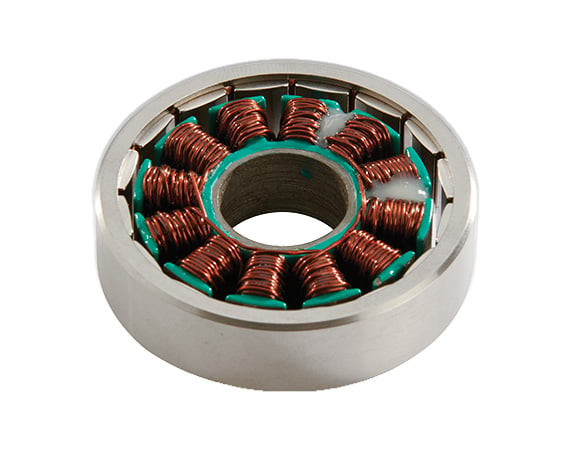The pole count of a motor is the number of permanent magnetic poles, north and south, on the rotor. There is always the same number of north and south poles on the rotor. For example, in a 12 pole motor, there are 6 north poles and 6 south poles. This motor would also be considered a 6 pole-pair motor.
Benefits of Motor Pole Count
Benefits to having a high pole count motor include:
- Maximized inner diameter (ID) to outer diameter (OD) ratio
- Reduced weight
- Higher frequency cogging torque (related to slotted motors)
- Higher motor efficiency
Increasing the number of magnetic poles means you can fit more small magnets into the motor, reducing the stresses on the magnet bond lines. The higher pole count also maximizes the inner diameter (ID) to outer diameter (OD) ratio, resulting in reduced motor weight. As the pole count increases, the number of slots in the stator and the frequency of cogging torque increase. This higher frequency disturbance can be more easily filtered by motor/load inertia than that of a low slot/pole count motor. Lastly, when pole count is higher, less copper wire is left on the end-turns of the windings (non-torque generating), reducing I2R power losses.
While there are advantages to increasing pole count, there are also some disadvantages.
Disadvantages of High Motor Pole Count
Disadvantages to having a high pole count motor include:
- Higher eddy current losses
- Increased frequency-dependent hysteresis losses
- Higher servo drive current loop bandwidth
- Reduced maximum speed
Electrical frequency of a motor is proportional to the number of poles, therefore increasing the pole count increases the electrical frequency. This could negatively affect the system in various ways. The rapidly changing magnetic field induces larger eddy currents in the stator core, which is realized as power losses. The alternating magnetic field will also induce hysteresis losses. The higher electrical frequency puts a bigger burden on the servo drive current loop frequency, as it now must keep up with the electrical frequency of the motor. However, in most cases, servo drives offer current loop sampling rates that are much greater than the electrical frequency of typical brushless motors. Lastly, as the pole count increases, the back emf constant (Ke) increases. This means that for the same bus voltage to the motor, the maximum speed decreases. Alternatively, the bus voltage must be increased to achieve the same maximum speed.
Both advantages and disadvantages of a high pole count motor are considered during the design process to ensure the motor meets the needs of the target application.
Click for more information on Celera Motion’s direct-drive frameless motor kits.



